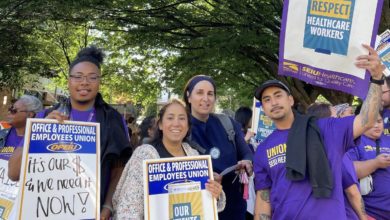Over 40 years ago, a 21-year old mother wanted to terminate her third pregnancy. Her life wasn’t in danger which was the only legal reason she could get an abortion. The abortion provider who would provide an illegal termination had been shut down. While this is thought of as history, she was in the position that many many women today find themselves–unable to access abortion care.
Two lawyers, Sarah Weddington and Linda Coffee, took her case and argued it all the way to the Supreme Court. The Roe v. Wade decision established the right to an abortion throughout the country at a time when the women’s movement had made reproductive rights a central pillar of the struggle, although certainly not the only one. The Court’s decision said that the right to privacy included a women’s right to make her own personal medical decisions.
Before Roe v. Wade, in 1965, abortion caused 17 percent of all pregnancy related deaths. According to the Guttmacher Institute, 8 percent of low-income women in 1960s New York City had attempted an illegal abortion. Seventy-seven percent tried to perform the abortion themselves. Thirty-eight percent of women interviewed in the study knew someone close to them who had attempted an abortion. Rachel Benson notes in the same Guttmacher article that “In 1962 alone, nearly 1,600 women were admitted to Harlem Hospital Center in New York City for incomplete abortions.”
Since the women’s movement won with Roe v. Wade in 1973, it has been under attack. In the last ten years, those attacks have only escalated. This year, 2018, has already witnessed an enormous escalation in the right-wing, misogynistic battle against reproductive rights. From January to March, 37 states introduced measures to restrict abortion or birth control.
In Iowa, the governor signed into law a limitation allowing for abortions only until a heartbeat is recognizable, about 6 weeks. There are few countries with abortion bans as restrictive as this. In fact, Ireland is holding a referendum on this very issue–to roll back a similar ban– on May 25 with thousands of doctors urging a yes vote to to repeal the 8th amendment that has in effect banned abortion in the country.
Earlier in the year, Mississippi Gov. Phil Bryant signed a law banning abortion after 15 weeks, with no exceptions in cases of rape or incest. The law has already been challenged in the courts and was ordered on hold by a judge the day after it went into effect.
In Arizona, women are now required to explain why they need an abortion. There’s a bill in the Louisiana legislature to make forcing a women to get an abortion a violent crime. The bill is clearly intended to continue the assault on women’s rights by creating the mistaken perception that women are frequently coerced into abortions.
So many of these laws are unconstitutional. These rightwing attempts to pass law after law are part of the multipronged attack on abortion rights. First, they hope to get to the Supreme Court and overturn Roe v. Wade. Second, in the meantime, they intend to chip away at abortion rights with highly restrictive laws that limit abortion rights under Roe without overturning it outright. Finally, the constant barrage of anti-abortion and anti-birth control legislation is fueling a propaganda campaign to moralize and pathologize women’s reproductive rights. The names of the bills themselves use words like “fetal pain” and “heartbeat bill” to manipulate peoples’ feelings about abortion.
Abortion, like birth control, is a straightforward modern medical procedure that ensures the right to control your own body. These are not moral questions but healthcare questions that should be left to the individual to decide: not to get pregnant or not carry a fetus to term, for whatever reason or reasons that might inform that decision.
The reality is that while the United States may recognize a women’s right make medical decisions and the right to abortion as “the law of land,” access is so highly limited that it would be hard to say it is actually a right. Of course, rich women have access to abortion because it is law of the land. But poor women are functionally denied the right to abortion, a fundamental reproductive right; even access to birth control has been repeatedly challenged.
There have been pockets of organizing against these attacks on abortion in each state as those attacks take place. Organizations and individuals have sometimes come out in the streets, more often waging a legal battle to overturn the laws. There have certainly been victories, like the mobilization against the Albuquerque citywide ban in 2013. However, the resistance remains isolated to particular states and localities, and is primarily defensive. The question is whether the women’s movement can come together and organize the independent and militant wave of activism and resistance necessary to turn the rightwing tide and again win back the right to abortion.





